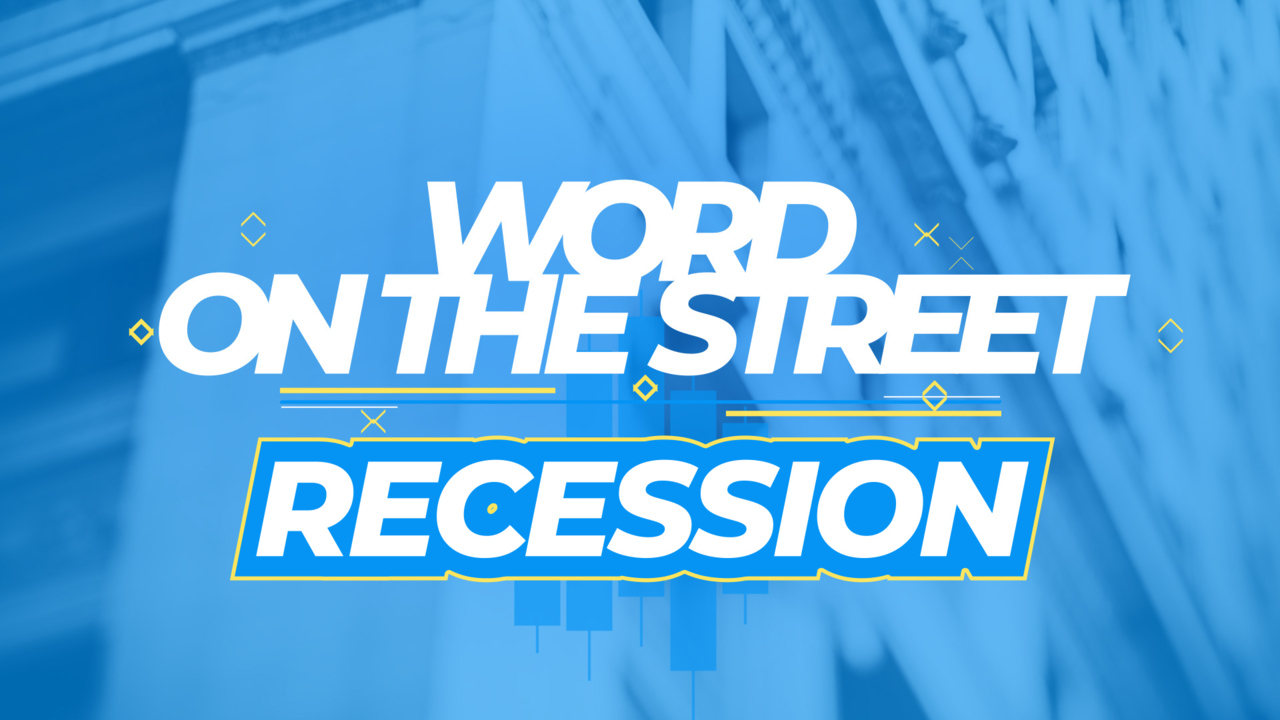
NEWS CLIP: we think we’re in a recession.
NEWS CLIP: i think we’re either in a recession right now or going to be in one in the next 12 months.
SIMONE DEL ROSARIO: THE WARNING SIGNS ARE FLASHING.
NEWS CLIP: i think the likelihood of a recession is clearly increasing
SIMONE DEL ROSARIO: WITH A MARKET DOWNTURN – SLOWING ECONOMY – AND EVER-TIGHTENING FED POLICIES, EXPERTS SAY THE U-S COULD BE HEADING TOWARD A RECESSION – IF WE’RE NOT ALREADY THERE.
NEWS CLIP: we think the odds are sort of 50/50 now i mean they’ve increased materially since the beginning of the year.
SIMONE DEL ROSARIO: YOU MAY IMMEDIATELY THINK BACK TO HOW BAD IT WAS IN 2008. BUT NOT ALL RECESSIONS ARE AS “GREAT.”
SO WHAT CONSTITUTES A RECESSION? AND WHEN DOES A RECESSION BECOME A DEPRESSION?
LET’S GET INTO IT IN TODAY’S WORD ON THE STREET.
A RECESSION IS A SIGNIFICANT DECLINE IN ECONOMIC ACTIVITY SPREAD ACROSS THE ECONOMY, LASTING MORE THAN A FEW MONTHS.
GENERALLY, WE THINK OF A RECESSION AS TWO CONSECUTIVE QUARTERS OF NEGATIVE ECONOMIC GROWTH, CALCULATED BY THE COUNTRY’S GROSS DOMESTIC PRODUCT, OR GDP.
BUT THE OFFICIAL CALL ABOUT WHETHER WE’RE IN A RECESSION – ACTUALLY COMES FROM THE NATIONAL BUREAU OF ECONOMIC RESEARCH: A PRIVATE, NONPARTISAN ORGANIZATION MADE UP OF ECONOMISTS.
AND THEY SAY A TWO-QUARTER GDP DECLINE – IS NOT EXACT. IN THEIR EYES, A RECESSION USUALLY LASTS FOR SEVERAL MONTHS – AND IS SEEN NOT JUST THROUGH GDP, BUT ALSO INCOME, EMPLOYMENT, INDUSTRIAL PRODUCTION AND SALES.
THAT SAID, THE FIRST QUARTER OF 2022 – THE ECONOMY DID CONTRACT, RAISING RECESSION FEARS.
SENATOR ELIZABETH WARREN: you know what’s worse than high inflation and low unemployment? It’s high inflation and a recession with millions of people out of work.
SIMONE DEL ROSARIO: MANY SAY THE FEDERAL RESERVE’S BELATED EFFORTS TO TAMP DOWN ON INFLATION, COULD TIP THE COUNTRY INTO RECESSION.
WHAT’S MORE – THE FED SEES IT TOO.
CLEVELAND FED PRESIDENT LORETTA MESTER: the recession risks are going up partly because monetary policy could have pivoted a little earlier than it did :46 we’re doing that now by moving interest rates up.
SIMONE DEL ROSARIO: AND WHILE A LOOMING RECESSION FEELS SCARY – THE TRUTH IS – IT’S A PRETTY NORMAL PART OF OUR ECONOMY.
WE HAVE THESE PERIODS OF EXPANSION, AND THEN WE CONTRACT A BIT.
THE LONGEST EVER EXPANSION ACTUALLY FOLLOWED THE GREAT RECESSION AND ENDED WITH THE PANDEMIC.
ZOOM OUT – AND YOU’LL SEE SINCE 1950, RECESSIONS HAVE HAPPENED ON AVERAGE ABOUT EVERY SIX YEARS.
WHAT’S FAR LESS FREQUENT – IS A DEPRESSION.
THAT’S WHEN AN EXTREME GLOBAL RECESSION LASTS YEARS, NOT MONTHS.
THE GREAT DEPRESSION IS THE ONE EXAMPLE THAT COMES TO MIND, WHICH TECHNICALLY LASTED FROM 1929 TO 1933.
NOW, CENTRAL BANKS ARE QUICKER TO STEP IN. EXPANSIONARY MONETARY POLICIES HELPED STOP THE GREAT RECESSION FROM BECOMING A FULL BLOWN DEPRESSION. AND IT’S UNLIKELY THE FED WILL LET A GREAT DEPRESSION HAPPEN AGAIN.
BUT THEY MIGHT LET THE ECONOMY FALL INTO A RECESSION – ESPECIALLY IF IT MEANS BRINGING DOWN INFLATION.
NEWS CLIP: I don’t think it’s inevitable there’ll be a recession. I do think it’s tough to avoid a recession but it’s not inevitable.
SIMONE DEL ROSARIO: IN ANY CASE, YOU NOW KNOW WHAT IS A RECESSION. SO WHAT FINANCIAL TERM DO YOU WANT EXPLAINED NEXT IN WORD ON THE STREET. LET ME KNOW BELOW.










